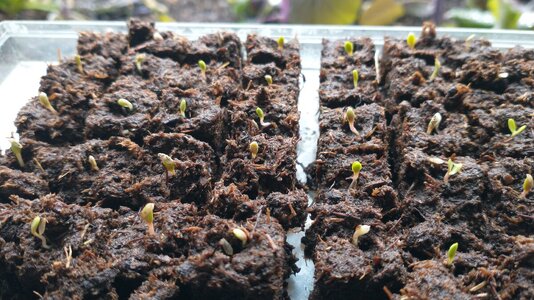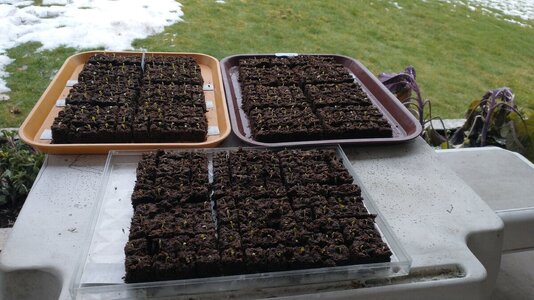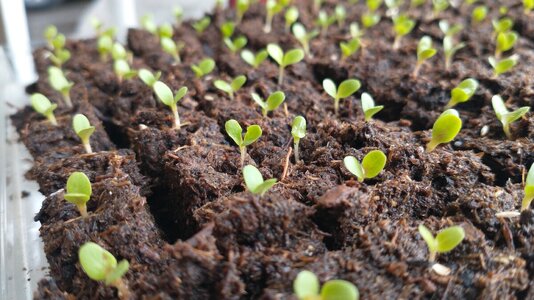Branching Out
Deeply Rooted
Several years ago a friend gave me a selection of homegrown lettuce seedlings for my birthday, and one plant in particular stood out. Its leaves were green with ragged edges, and it had dark purple blotches dotting its foliage. This was, in my view, a seriously unattractive lettuce. I planted it alongside the other lettuce seedlings that I had received, and over the following weeks this little plant blossomed into a very interesting specimen. In particular was the discovery that its purple-flecked leaves were thick and crunchy-- even in the heat of a warm June day. At the time I had never heard of a 'crisphead' lettuce, and I did not even know that growing lettuce with crisp leaves in summer was even possible. Before long I fell in love with this variety, and by the following year many friends and neighbours had been similarly smitten.
This was my introduction to Jester lettuce, and its breeder Frank Morton. Frank is my lettuce hero. Over the past few years I've read a lot about his lettuce breeding journey, and Frank's work has inspired me to try my hand at creating my own lettuce cultivars as well. I read and reread Frank's essay 'On Lettuce Breeding,' gave some thought as to which lettuce to cross, and got to work. https://www.wildgardenseed.com/articles/on-lettuce-breeding
My first attempt was in the spring of 2023 when I planted two large patches of Romaine lettuce, one red and one green, in an effort to cross them. Unfortunately for me the green Romaine flowered a full two weeks earlier than the red variety, so I was not able to achieve what I had set out to do. That kind of wasted my first year of lettuce breeding, but I made a note of the disparity in days to maturity and then in spring of 2024 I repeated the process. This time I sowed the green Romaine seeds a full two weeks earlier than the red, and then I planted out the red and green seedlings in a checker board pattern in the garden. Thankfully that worked. The plants bolted at about the same time, so the stalks could be 'married' together for a few weeks to encourage cross-pollination by tiny insects such as thrips. After that the seed heads were separated again, so the seeds could be collected separately from the green and red varieties.
It's taken two years to get to this point, and next comes the hard part. I have large quantities of seed that I will need to grow out, in order to look for anomalies that would indicate a successful cross. I'm not sure how large the seedlings have to grow before differences in leaf colour or form will become apparent, but I'm hoping that the seedlings will offer clues as to their pedigrees within 2-3 weeks, when the plants are still tiny. If I can spot the crosses and grow out these F1 plants to maturity the next step will be to save lots of seeds for the F2 generation-- which is where Frank says the widest range of diversity is found. This is all sounding a tad overwhelming, but I'm a couple years into this project and it would be sad to stop now.
Pictured second from left are three trays of 3/4" soil blocks that were started on February 10th, with 120+ blocks per tray. The clear tray in the foreground is the first round of seeds for this cross. Update: on February 20th (at the ten day mark) each small block had a seedling growing happily.
This was my introduction to Jester lettuce, and its breeder Frank Morton. Frank is my lettuce hero. Over the past few years I've read a lot about his lettuce breeding journey, and Frank's work has inspired me to try my hand at creating my own lettuce cultivars as well. I read and reread Frank's essay 'On Lettuce Breeding,' gave some thought as to which lettuce to cross, and got to work. https://www.wildgardenseed.com/articles/on-lettuce-breeding
My first attempt was in the spring of 2023 when I planted two large patches of Romaine lettuce, one red and one green, in an effort to cross them. Unfortunately for me the green Romaine flowered a full two weeks earlier than the red variety, so I was not able to achieve what I had set out to do. That kind of wasted my first year of lettuce breeding, but I made a note of the disparity in days to maturity and then in spring of 2024 I repeated the process. This time I sowed the green Romaine seeds a full two weeks earlier than the red, and then I planted out the red and green seedlings in a checker board pattern in the garden. Thankfully that worked. The plants bolted at about the same time, so the stalks could be 'married' together for a few weeks to encourage cross-pollination by tiny insects such as thrips. After that the seed heads were separated again, so the seeds could be collected separately from the green and red varieties.
It's taken two years to get to this point, and next comes the hard part. I have large quantities of seed that I will need to grow out, in order to look for anomalies that would indicate a successful cross. I'm not sure how large the seedlings have to grow before differences in leaf colour or form will become apparent, but I'm hoping that the seedlings will offer clues as to their pedigrees within 2-3 weeks, when the plants are still tiny. If I can spot the crosses and grow out these F1 plants to maturity the next step will be to save lots of seeds for the F2 generation-- which is where Frank says the widest range of diversity is found. This is all sounding a tad overwhelming, but I'm a couple years into this project and it would be sad to stop now.
Pictured second from left are three trays of 3/4" soil blocks that were started on February 10th, with 120+ blocks per tray. The clear tray in the foreground is the first round of seeds for this cross. Update: on February 20th (at the ten day mark) each small block had a seedling growing happily.
Attachments
Last edited:



